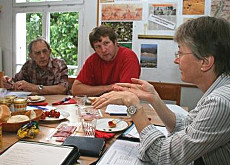Clock Tower rings out in Berne, Indiana

What originally seemed a crazy idea, on Saturday evening became reality: a replica of Switzerland’s Zytglogge tower now stands in Berne, Indiana.
The town’s new landmark was officially opened – to great fanfare – as part of the Swiss Days festival. August 1 is Swiss National Day.
At first glance, the tower looks slightly surreal – sticking out of the town’s main crossroads. The flat landscape means the tip is visible from one kilometre away.
The imposing size is what makes people stand in awe when they see it for the first time. The tower is a success. The 2,500 or so people who came from far and wide surprised even the organisers. Critical voices, which had been heard for a while, were largely absent.
At just under 49 metres, the replica is marginally smaller than the original in the Swiss capital, Bern. It is intended on the one hand to be a memorial monument to the founding generation who arrived in the area in the middle of the 19th century.
It is also hoped however that the tower will give the town a boost for the future, notably concerning tourism.
Private donations
The Munsterberg Clock Tower, as it has been named, alludes to the first settlers, a group of Mennonites from the Jura region in Switzerland who emigrated to the United States in 1852 in order to be able to practise their religion without persecution.
Even today, religion and faith plays an important role in the lives of the people in Berne, Indiana.
The Clock Tower is the result of a private initiative and was funded by private donations. The community sold the organisers the land – some 8,000 square metres – for the symbolic price of one dollar, as Berne’s mayor John Minch told swissinfo.ch.
Six buildings and an old petrol station had to be sacrificed, although one was moved elsewhere.
The funds, around $3 million (SFr3.12 million), were collected over five years, with most coming from families and individuals. Work started in spring 2010.
Settlement story
A further million dollars is still needed to complete the project, including a square next to the tower with benches, fountains and a pavilion.
Also, the inside of the tower has yet to be finished. A look-out point is planned at around 25 metres, with windows in all four directions, as well as a small museum containing historical elements relating the town’s history.
The tower already shares with the original however a clock and a carillon. The 12 little figures did their thing for the first time on Saturday evening. In future the carillon should play every day at noon and six in the evening.
The 12 figures tell the settlement story of Berne, which began with a ship, the Hahnemann, which took the Mennonites from Le Havre in France to New York.
The journey was tough, with not all on board, including several children, surviving the crossing or the trek to Indiana.
Another figure on the clock face portrays the trip overland using horse coaches. This is followed by scenes from the lives of farmers, people praying, a teacher, an Amish family, an alphorn blower and a harmonica player, and two people dancing.
Fundamental values
Engraved on the tower are eight fundamental values such as faith, courage, integrity and hard work – but also vision and hope, which remind one not only of the founding generation and their values, but also of the current and future generations, for whom they should serve as constants in ever-changing times.
These values were also the focus of the speeches delivered at the inauguration on Saturday evening.
Keith Reinhard, a successful advertising executive, titled his speech “Enduring values for changing times. That’s what you learn in Berne.”
He pointed to the contrast between the clock, which rang every hour and stood for change, and the permanence of the values chiselled into the stone, which remained valid today.
Before the ceremony, Reinhard, the tower’s biggest sponsor, told swissinfo.ch that he had left Berne immediately after leaving school.
“I was restless. Berne was too small for me, too conservative,” he said, adding that he wanted to get into advertising, which back in the 1950s you could only do in the cities.
“It took time before I realised how many important basic things I learnt in Berne, for example the work ethic, which set me in good stead later on in life.”
Rita Emch in Berne, Indiana, swissinfo.ch (Translated from German by Thomas Stephens)
In 1852 a group of 70 Mennonites from the Jura in Switzerland arrived in the area.
In 1871 the community was registered as Berne and a train went through Berne for the first time.
The train connection resulted in more immigrants, mostly from Switzerland and Germany. Economic expansion began.
Berne today has around 4,150 inhabitants. Some 4,000 Amish have settled outside the town.
Berne is proud of its Swiss roots and the descendents of the settlers lay great value on the tradition of their forefathers’ home.
Swiss influence is everywhere: as conspicuous as the many Swiss names and coats of arms on shops and residential buildings is the floral decoration – geraniums line window boxes and roads.
Family names that give away their Swiss origins include Graber, Amstuz, Lehmann, Neuenschwander, Liechti and Sprunger.
Swiss Days has been taking place at the end of July in Berne for more than 30 years, recently attracting 20,000-30,000 visitors a year.
It is organised by the local chamber of commerce.
The programme includes Swiss food, music, dancing, exhibitions and other attractions.

In compliance with the JTI standards
More: SWI swissinfo.ch certified by the Journalism Trust Initiative















You can find an overview of ongoing debates with our journalists here . Please join us!
If you want to start a conversation about a topic raised in this article or want to report factual errors, email us at english@swissinfo.ch.